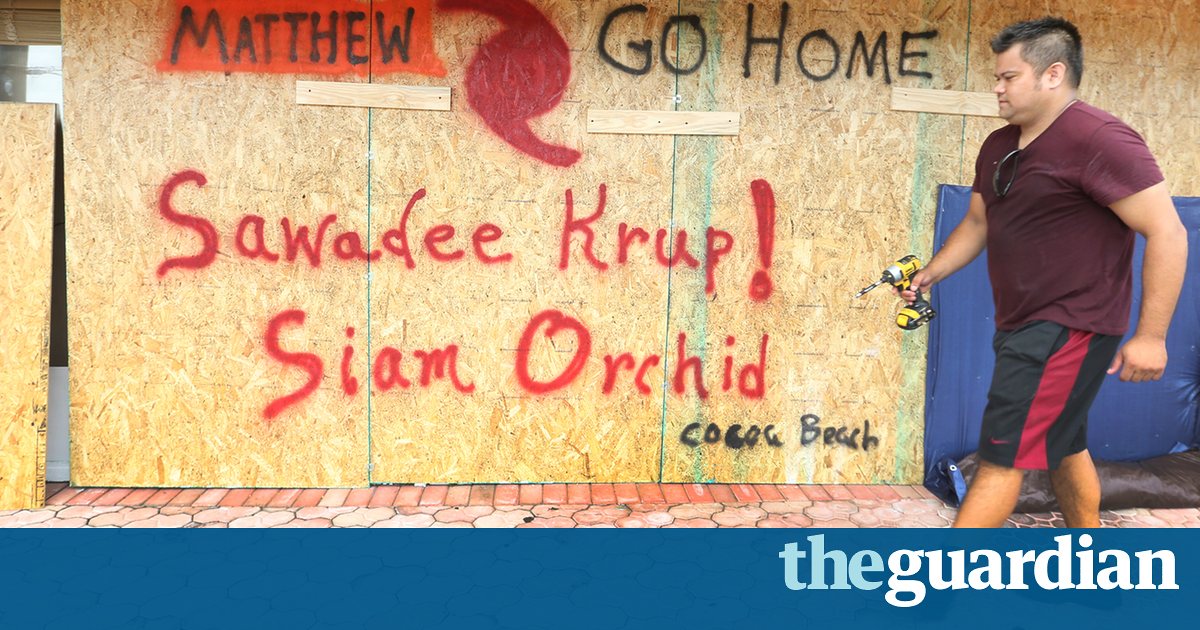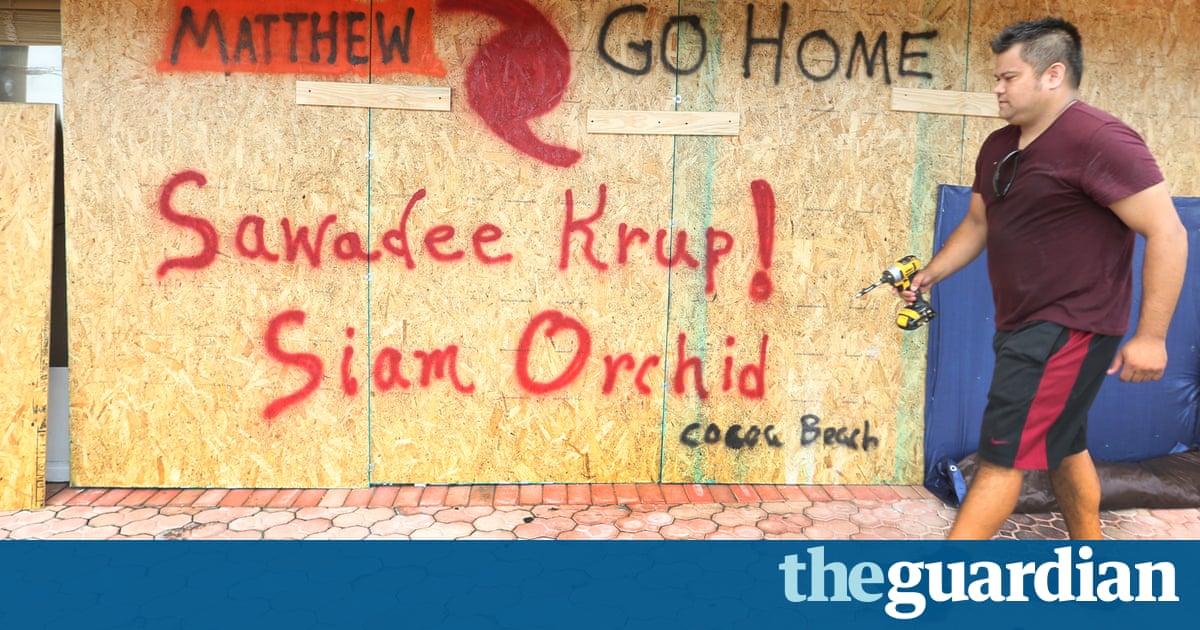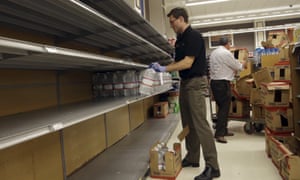Hurricane Matthew: Floridians urged to hurry preparations as storm approaches

Governor Rick Scott: Our number one priority is protecting lives as storm threatens to be first major hurricane to make US landfall since 2005

Officials urged residents along Floridas east coast to rush emergency preparations to completion late on Wednesday as deadly Hurricane Matthew, one of the most powerful storms in recent history, bore down on the state from the Caribbean and threatened a direct hit.
Hundreds of thousands of people were evacuating from vulnerable coastal areas ranging from Fort Lauderdale north to Cape Canaveral as the category 3 storm, which claimed at least 11 lives as it passed across Haiti and the Dominican Republic on Tuesday, drew closer.
By 5pm on Wednesday, Matthew was churning through the islands of the Bahamas, 400 miles south east of Palm Beach, with maximum winds gusting in excess of 150mph. The Miami-based National Hurricane Center (NHC) said in its latest advisory that although the eye of the storm was expected to remain just offshore as it hugged the coastline on its path north through Thursday and Friday, its path was unpredictable and landfall was still a possibility.
Dangerous tropical storm force winds extended for 175 miles from the center, the NHC said, and time was running out to prepare.
Conditions will go down pretty quickly tomorrow in the morning hours, said Ed Rappaport, deputy director of the NHC. Everyone in south Florida will experience at least tropical storm force winds, and if it makes landfall it will be far worse than that.
We expect storm surge of three to five [feet] along the coast, and thats a serious concern. The greatest risk for loss of life is from storm surge. Most people think about the winds when they think about a hurricane but its really the water that takes lives.
If Matthew does come ashore, it would be the first major hurricane to make landfall in the United States since Wilma in 2005. Barack Obama, during a visit to the headquarters of the Federal Emergency Management Agency (Fema) in Washington, warned against complacency.
This is a serious storm. Everybody needs to be paying attention and following the instructions of your local officials, he said.
You can always rebuild, you can always repair property, but you cannot restore life if it is lost and we want to make sure that we minimize any possible loss of life or risk. By tomorrow morning it will already begin to have significant effect in Florida and then has the potential to strengthen and move on up the coast.
In its advisory, the NHC extended its posted hurricane warning farther north to cover almost the entire east coast of the state from Miami to Jacksonville. While the states of Georgia and North and South Carolina were also still under a state of emergency, the latest five-day projection took the storm away from their coastlines and into the Atlantic, with the greatest impact expected in Florida.
After that, an increasing number of model projections have the storm looping back and perhaps making a second assault on the east Florida coast by the middle of next week.
Rick Scott, the Florida governor, announced at an emergency briefing earlier on Wednesday that mandatory evacuations were under way for Brevard Countys barrier islands, including Merritt Island and Cocoa Beach. Shelters would be open for displaced residents, he said, and those living in mobile homes or in flood-prone and low-lying areas should also decide to evacuate voluntarily.
Our number one priority is protecting lives, Scott said. The storm has already killed multiple people and we should expect the same impact in Florida if people do not take this seriously.
Wilma, the last major hurricane to strike Florida, in October 2005, was blamed for 35 deaths in the state and caused damage in excess of $20bn. Many residents were without power for weeks and there were significant fuel shortages, something Scott said Florida was better prepared for this time.

He said 500 national guard troops had been activated to help with rescue and recovery operations once the storm had passed, and a further 6,000 were placed on standby. Schools across south Florida will close on Thursday and Friday, and utility companies were stationing crews in safe areas ready to move in and help restore power.
Florida Power and Light, the states biggest electricity provider, said it had invested up to $2bn improving grids and power lines since Hurricane Wilma and 4,000 workers were standing by to perform repairs. Meanwhile, gas stations and home improvement stores across south and central Florida reported brisk business on Tuesday and Wednesday as Floridians heeded officials advice to stock up on at least three days worth of supplies.
Bottled water disappeared from supermarket shelves as soon as it was restocked, causing shortages in many areas, and several gas stations in Coral Springs, Margate and Fort Lauderdale were closed and taped off on Wednesday morning having sold the last of their fuel.
Home Depot and Lowes stores saw long lines for dwindling supplies of plywood to shutter windows. Water management officials lowered lake and canal levels south of Lake Okeechobee to accommodate the expected deluge of rain, with one potential concern the stability of the ageing dike walls and flooding risk.
You worry about that part of it as well because its going to drop a lot of water, its a wet event, said Florida senator Marco Rubio, who said he had spoken to the army corps of engineers, responsible for maintaining the 730-sq-mile lake.
They feel they have assets in place to deal with any sort of contingency where the water comes over the top or if theres any, God forbid, failure of the dike.

During his Fema visit, Obama also touched on the devastation caused by Hurricane Matthew in Haiti, where at least seven people were killed in flooding and mudslides, according to aid agencies. Four other deaths were reported in the neighboring Dominican Republic.
Haiti, one of the poorest countries in the world, already suffering from a range of previous disasters, has been hit really hard by this storm and we anticipate that theyre going to need substantial help, Obama said.
There may be similar needs in places like the Bahamas.
Read more: https://www.theguardian.com/us-news/2016/oct/05/hurricane-matthew-florida-evacuates-barrier-islands